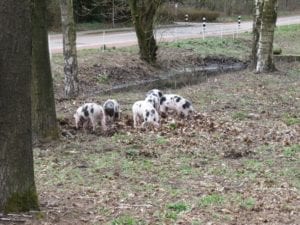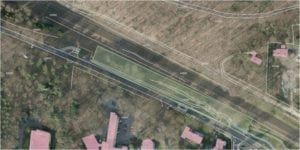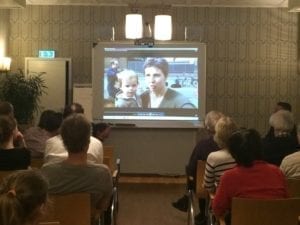(Thanks to De Groene Vinger, the news about this project has reached the United Kingdom. That’s why we wrote this English-language summary.) In the village of Oosterbeek in The Netherlands on april 2nd 2015 an experiment was initiated using pigs (the rare breed ‘bonte bentheimer’) to fight japanese knotweed.

Japanese knotweed is a very invasive plant. The Dutch authoroties started a experimental program to find our which manner is the best to fight it: regular mowing (ten years?), using chemicals, moving top soil, covering with black foil and other means.
Using animals is not part of it. Probably no-one thought of it.
Hence, this experiment with pigs, is not part of the official program, but may be considerd as an interesting addtion. The Organic Way.
In the United Kingdom the problems with japanese knotweed are even bigger than in The Netherlands. Read e.g. this article in The Guardian.
How it begun
It started somewhere in late 2014, when the alderman Wendy Ruwhof of the community of Renkum, to which Oosterbeek belongs, visited the gardens of MergenMetz. How it came up, is still unclear, but at a sudden moment Wendy and Norbert were talking about using pigs to fight japanese knotweed.
 MergenMetz breeds the rare pig bonte bentheimer, of which approximately 2,000 exists in The Netherlands and Germany.
MergenMetz breeds the rare pig bonte bentheimer, of which approximately 2,000 exists in The Netherlands and Germany.
On the site where the pigs live, japanese knotweed had gone, whiped out, eradicated. The pigs ate the leaves as well as the roots. Pigs dig deep (50 cm up to 1 meter), when they want.
Towards the end of 2014 plans were made with André Menting (responsible for the nature and landscaping in the community) and agrarian artist Sjef Meijman. Norbert Mergen of MergenMetz and Sjef Meijman knew eachother, they both were in the board of the association ‘Het Nederlandse Bonte Bentheimer Landvarken’.
The Pig House

In the past couple of years Sjef and a collegue artist carried out a project called Het Varkenshuis (The Pig House). Bonte bentheimers were placed in the urban area of local communities (e.g. the city of Rotterdam) and fed by the people who lived around the lot. Sjef had the necesary experience in how pigs and people behave when they live together in the same road and which measurements had to be taken. (Little to nothing.)

On the 2nd of March 2015 the civilians living near the test site were informed.
In his presentation Sjef incorporated fragments of TV reports that were made about The Pig House and everyone was immediately enthousiastic.
Almost everyone volunteered as Assistant Farmer. (They keep an eye on the animals and feed them.)
The experiment
April 2nd 2015 six little piglets (all sows) were released on a 5,000 sq m test site.
It is an experiment, so it is to learn. And what we learned up until know is:
- six piglets on 5,000 sq m is too few. Six matures would be okay
- the area is (was) very rich on good tasting food (lesser celandine, sorrel, hogweed, acorns, sweet chesnuts et cetera)
- supplying additional organic pig feed was reduced in time when plants started growing – at the end of May we stopped additional feeding for a couple of weeks
- around the 5th of June the pigs started to eat the japanese knotweed – many other greens had been eaten before, except for e.g. cow parsley
- it is a public attraction – may people make a detour to see the pigs. People now see these animals in a more natural habitat.
- we think that the plant will not been eradicated at the end of the year, because of the start with piglets and the size of the plot. Part of the “game” is that the animals also dig out the roots.


Hi, could you give an update on this please. Is the site still infested with knotweed or is it all gone? If still infested, did the pigs make the infested area smaller or larger? I imagine consistent feeding may have weakened the patch, so it should be smaller or even gone. Then again, the pigs may have dropped bits that regrow and thus spread them further. Really interested in seeing pics from 2015 and 2017 just to get an idea.
This is the third season. Every time half a year from April till October. They are doing fine, but the area is too large for a small amount of pigs. Like putting a few people in a huge vegetable garden: they will not eat all. The Dutch law does not allow more than five pigs – if more, the rules en laws for intensive pig breeding are applicable: every x week taking blood samples et cetera. In my private situation two pigs on 500 sqm worked fine. This area is 5.000 sqm. The Japanese knotweed grows there were the animals hardly come.
So basically, it shows that it works. The other options are: ten years of spraying chemicals or every fortnight injecting every stem with glyphosate, manual removal, covering with a thick black foil – approx. ten years (they did in the German Harz Mountains).
Thanks Norbert. Just to add if you do use glyphosate, it only needs to be applied once a year, in autumn, when the natural plant juices go down into the roots. This is where you want the herbicide. Spraying or injecting in spring or summer is a waste of poison as it only kills above ground plant parts, which can just as easily be cut (also pointless but at least without herbicide). Injecting every fortnight would be ludicrous. I have used cut-and-inject, only applied in Sept/Oct and I find it works well. It hasn’t led to a full kill after one application, but regrowth is severely reduced the following season, and can then be managed manually.
Hello!
Any update,how the pigs success your goal?
Still fight or done long time ago?
Would love to hear from you.
Regards
Tamàs
Japanese Knotweed is not on the top of pig’s favourite food list. It’s all relative. I think it works – it worked for us – but this area is too big in relation to the number of pigs. Plus passers-by and local residents feed them too much. So the area is partly clean, partly much less knotweed and partly knotweed because the pigs don’t get there.
Thank you sir !
Well i have few hundred square meters infected area,im gonna dig the big ones,after cover the whole area with foil and then see how it is goes. Then let few pigs to do the rest if still grows. 🤔☺